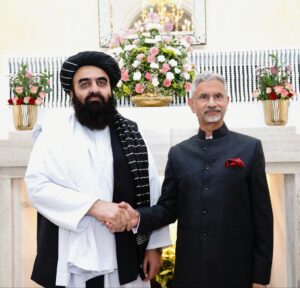A Love Without Preconditions!.
How to Love Your Spouse Unconditionally:
By Dr. Fiaz Maqbool Fazili
Love in marriage, much like life itself, is never static. It breathes, evolves, and sometimes bleeds under the weight of unmet expectations and human flaws. The idea of loving someone unconditionally—especially a spouse—is often glorified in poetry, religion, and philosophy, yet rarely practiced in the daily grind of shared existence. Unconditional love is not a sentimental phrase or a romantic illusion; it is a deliberate, disciplined act of the heart. It means giving your partner what they need the most, when they deserve it the least, at great personal cost to yourself.
When I first heard those words more than three decades ago, they struck me as both profound and painfully demanding. At the time, I was a young husband, navigating the uncharted territory of marriage with all the impatience and ego of youth. Those words, however, became a quiet compass—guiding me through arguments, disappointments, and moments of emotional drought. They taught me that love without conditions is not about perfection or permanent harmony. It is about choosing your partner, every day, especially when they are hardest to love. In a world increasingly defined by transient connections and conditional agreements, the sanctity of marital love faces unprecedented challenges. This piece explores the profound, often difficult, yet ultimately transformative practice of loving a spouse without conditions—a journey not of perfection, but of persistent, grace-filled choice. It is a reflection drawn from decades of lived experience, offered not as a prescription, but as a testament to the enduring power of a love that chooses to see, accept, and cherish.
Marriage, by its very nature, tests the elasticity of love. It places two imperfect individuals under the same emotional roof and asks them to build a life together. There are seasons when everything feels effortless—when laughter fills the kitchen, when plans align, and when the smallest gestures feel enough. But there are also days when silence stretches longer than words, when fatigue replaces affection, and when both partners feel unseen or misunderstood. It is in those fragile spaces that unconditional love either takes root or withers.
To love your spouse unconditionally is not to ignore their flaws or excuse their mistakes. It is to accept their humanity and choose to see the whole person—the good, the difficult, and the growing. It means extending grace, not as an act of surrender, but as a conscious expression of strength. True love is not about fixing someone; it is about standing beside them as they evolve.
Society often measures love by reciprocity—the give-and-take that keeps relationships balanced. But unconditional love transcends that equation. It gives without keeping score. Yet, this does not mean self-erasure or tolerating emotional neglect. Loving without conditions does not mean living without boundaries. In fact, setting boundaries is often an act of love, both for yourself and for your spouse. When you continue to give endlessly without being emotionally nourished in return, you eventually drain your spirit. Love cannot thrive in an environment where only one heart beats for two.
The idea of unconditional love finds its most perfect expression in divine example. The scriptures remind us that love is patient, kind, and enduring—not because it is blind to faults, but because it chooses compassion over judgment. God’s love for humanity is not transactional; it is steadfast even in the face of betrayal and weakness. That sacred model of love is not meant to burden us with impossible ideals, but to remind us that love can indeed be both strong and forgiving at once.
Marriage offers the closest human opportunity to practice that divine kind of love. When we forgive, when we listen instead of reacting, when we show up in the midst of disappointment, we mirror something larger than ourselves. It is not a weakness to love deeply; it is a rare courage to do so when circumstances test your patience and pride.
In the daily rhythm of marriage, unconditional love often manifests in the smallest acts. Respecting your spouse’s opinions even when you disagree, listening with empathy, believing in their abilities, and encouraging them in moments of self-doubt—these gestures weave the quiet fabric of enduring love. When you speak about your partner with respect in front of others, when you make time for them despite the chaos of life, you are telling them that they matter, that they are seen. Love is not a grand declaration; it is in the consistency of everyday tenderness.
To love unconditionally is also to allow imperfection. Letting your spouse fail, make mistakes, or struggle without judgment is part of this sacred dance. Control may feel like security, but it often suffocates growth. When you step back and give them the space to fall and rise again, you are not losing power—you are nurturing partnership. You are saying, “I trust you to find your way, and I will still be here when you do.”
Encouragement, too, is a language of love. Be their loudest cheerleader, not their harshest critic. Celebrate their victories, however small, and acknowledge their efforts even when outcomes fall short. Gratitude has a quiet magic—it transforms ordinary moments into emotional connection. Saying “thank you” or “I love you” may sound simple, but those words have the power to remind your partner that they are cherished and valued.
Of course, none of this comes without struggle. Unconditional love demands humility, patience, and self-awareness. It asks us to confront our own egos, our need to control, and our fear of being vulnerable. It is far easier to love when love is reciprocated. But the real measure of love is how it behaves when tested—when it must stand alone, fueled only by commitment and faith.
I still remember a time when my marriage felt weighed down by silence and fatigue. I taped that quote—“Unconditional love is giving the other person what they need the most, when they deserve it the least, at great personal cost to yourself”—to my bathroom mirror. I read it every morning before stepping into the day. It reminded me that love is not an emotion to be felt, but a decision to be made. It reminded me that I was called to love my wife not because she was perfect, but because she was mine.
Over the years, that lesson has deepened. I have realized that unconditional love is not a single act, but a lifelong practice. It requires forgiveness that goes beyond apology, understanding that precedes explanation, and faith that transcends disappointment. It is the slow, steady choice to nurture a bond even when it feels easier to retreat.
When the dust of daily life settles, when careers shift and appearances fade, what remains is the quiet companionship built through decades of shared resilience. To love your spouse unconditionally is to see beauty in the ordinary, to hold space for each other’s humanity, and to continue reaching across the distance when words fail.
At the end of every long day, when I turn to the person who has walked beside me through storms and seasons, I am reminded of one truth: love that asks for nothing in return often gives back the most. It may not always look perfect, but it endures. It grows through grace. It redeems through time. And in that unspoken endurance lies the purest form of love—a love without conditions.
 and Logic
and Logic

 Junk Food Leads to Obesity and Lifestyle Diseases.
Junk Food Leads to Obesity and Lifestyle Diseases.